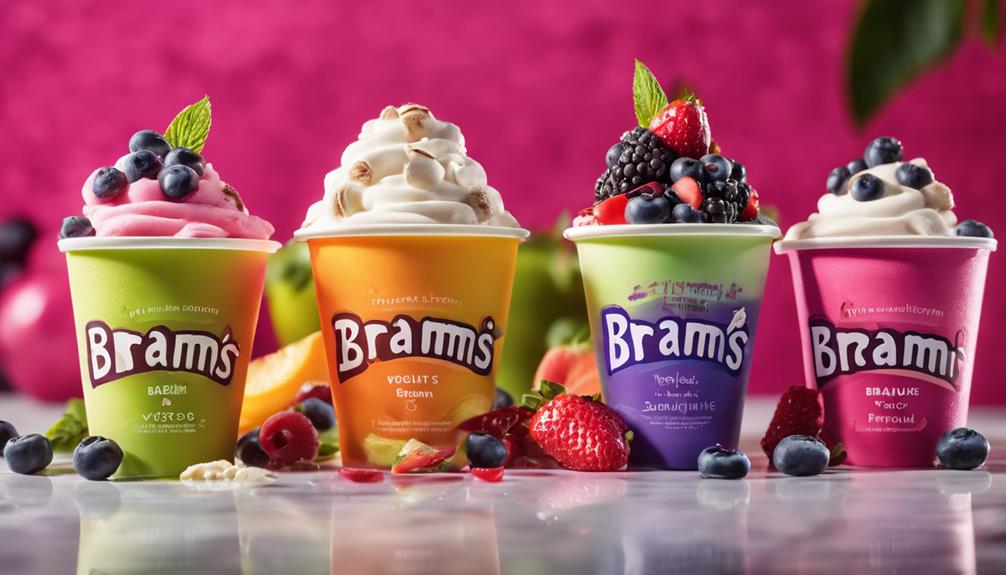When it comes to Italian ice cream, it’s important to understand the distinction between ‘gelato’ and ‘gelati.’ ‘Gelato’ refers to a single serving, while ‘gelati’ is the plural form, denoting multiple flavors or servings. Think of gelati as an exploration of different tastes, offering you a variety of delicious options. Gelato is typically considered a non-count noun, highlighting its luxurious, creamy texture. So, the next time you visit a gelateria, remember that if you want to try more than one flavor, simply ask for gelati, and you’ll uncover a world of delectable possibilities. There’s so much more waiting to be discovered!
Key Takeaways
- Gelato refers to a single serving of Italian ice cream, while gelati indicates multiple varieties or servings.
- Gelato is often treated as a non-count noun, whereas gelati is a countable noun.
- Gelati represents an exploration of various flavors and styles in the context of gelato.
- Regional preferences exist, with 'gelato' commonly used in the Northeastern U.S. and 'gelati' favored in Italian-American communities.
Understanding Gelato and Gelati
When you think about Italian frozen treats, it's vital to grasp the distinction between gelato, which refers to a single serving, and gelati, the plural form that signifies multiple varieties or servings.
Gelato is often touted for its rich flavor and smooth texture, making it a delightful alternative to traditional ice cream. While both gelato and ice cream are delicious, gelato typically has a lower fat content and denser consistency, allowing the flavors to shine more brightly.
When you enjoy gelati, you're exploring an array of flavors and styles, each showcasing the artistry behind this beloved dessert.
In Italian-American communities, the term gelati is frequently used to refer to these various offerings, making it an essential part of the culture's culinary landscape.
Understanding the nuance between gelato and gelati deepens your appreciation for this Italian delicacy, highlighting its significance in both everyday life and special occasions.
Key Differences Between Terms

Understanding the key differences between 'gelato' and 'gelati' enhances your appreciation for this delicious Italian treat. While 'gelato' refers to a single type of Italian ice cream, 'gelati' indicates multiple varieties or servings. This distinction is not just linguistic; it reflects a deeper understanding of Italian culture and culinary practices.
Here's a quick comparison to clarify:
| Term | Definition | Usage Example |
|---|---|---|
| Gelato | A single serving of Italian ice cream | "I enjoyed a scoop of chocolate gelato." |
| Gelati | Plural form indicating multiple servings or types | "We had several gelati flavors at the festival." |
| Ice Cream | General term for frozen desserts | "Ice creams come in various styles and flavors." |
In Italian, 'gelati' can describe different flavors or a collection of gelato types available at a gelateria. It's also worth noting that while 'gelato' is often treated as a non-count noun in English, 'gelati' is specifically a countable noun, representing several ice creams. Understanding these distinctions will enrich your culinary vocabulary and experiences.
Cultural Significance in Italy

Gelato isn't just a sweet treat in Italy; it plays an important role in daily life and social interactions, reflecting the country's rich cultural heritage.
You'll find gelaterias, or gelato shops, bustling with locals and tourists alike, enjoying a scoop of their favorite flavor, often accompanied by friends or family. These shops serve as social hubs, where you can savor the moment and indulge in a little piece of Italian tradition.
The seasonal flavors of gelato embody local ingredients, showcasing the agricultural bounty of various regions. As you explore different cities, you'll notice how each area offers unique interpretations of this iconic dessert, often referred to as Italian ice in other parts of the world.
The consumption of gelato evokes nostalgia, reminding many of cherished family gatherings and leisurely afternoons. Events like the International Gelato Festival highlight the craftsmanship and creativity behind this beloved dessert, further solidifying its cultural significance.
Nutritional Comparisons

When comparing gelato and ice cream, you'll notice some key nutritional differences that could influence your choice.
Gelato often has less fat and fewer calories per serving, making it a lighter option for those watching their intake.
Understanding these distinctions can help you make a more informed decision about which treat fits your lifestyle better.
Nutritional Content Differences
Nutritionally, gelato and gelati differ markedly in fat, sugar, and calorie content, impacting your dessert choices. When you're selecting your treat, understanding these differences can help you make an informed decision.
| Nutrient | Gelato | Gelati |
|---|---|---|
| Fat Content | 4-9% | Usually lower or dairy-free |
| Sugar Content | 20-30% | Varies based on ingredients |
| Calories | Generally lower than ice cream | Can be lower due to absence of cream and egg yolks |
Gelato's fat content, while higher, often comes from milk, which retains essential nutrients. In contrast, gelati offers flexibility with lower fat options and can be enriched with fruit or other natural flavorings. The sugar levels also play a significant role; gelato's sweetness is more consistent, while gelati's can fluctuate based on the ingredients used. Finally, the serving sizes differ—gelato is often consumed in smaller portions, which may help with calorie management, whereas gelati tends to be enjoyed in larger quantities due to its lighter texture.
Caloric Value Comparison
Understanding the caloric values of gelato compared to other frozen desserts can help you make more informed choices when selecting your sweet treat.
Gelato generally has fewer calories than traditional ice cream, with a typical serving containing around 150-200 calories. In contrast, ice cream usually ranges from 200-300 calories per serving. This difference primarily stems from gelato's lower fat content, which sits between 4-9%, while ice cream contains at least 10% milkfat.
The sugar content in gelato varies from 20-30%. This, along with its denser texture, can influence the overall calorie count. Additionally, serving sizes for gelato are often smaller than those for ice cream, helping you manage your calorie intake while still enjoying a rich flavor experience.
It's essential to note that nutritional values can vary considerably by flavor. For example, fruit-based gelatos often contain fewer calories than their chocolate or nut-based counterparts.
Production Techniques Explained

In gelato production, a slow churning process incorporates less air, resulting in a denser texture that sets it apart from traditional ice cream. This technique, combined with high-quality ingredients, creates a unique treat that's both creamy and flavorful.
The base ingredients for gelato typically include:
- Milk
- Sugar
- Cream
Using fresh, high-quality components enhances the overall taste. Pasteurization plays an essential role in the gelato-making process, ensuring safety while improving flavor development. Additionally, some producers add stabilizers to enhance texture and shelf life.
Gelato is churned at a slower speed than ice cream, which contributes to its rich creaminess. You'll also notice that gelato is served at a slightly warmer temperature compared to ice cream. This helps maintain its softer consistency and allows for a more intense flavor experience that you can truly savor.
Understanding these production techniques gives you a deeper appreciation for gelato, as they directly influence the taste and texture that make it a beloved dessert worldwide.
Popular Flavors to Try

Gelato offers a delightful array of popular flavors that cater to both classic tastes and adventurous palates. You can't go wrong with timeless options like chocolate and vanilla, which are rich and creamy, thanks to gelato's lower air content.
If you're in the mood for something invigorating, fruit-based gelati like strawberry and lemon are perfect choices. Made with real fruit puree, these flavors showcase the high-quality ingredients that define great gelato.
For those who crave something unique, consider trying salted caramel or pistachio. These artisanal combinations highlight the creativity of gelato makers and can elevate your taste experience.
Don't forget to explore seasonal flavors; pumpkin spice in the fall and fresh berry mixtures in the summer allow you to savor local ingredients and traditions.
Many gelato shops rotate their flavors regularly, so you'll always find new and exciting options to try. Each scoop delivers the denser, more intense flavors that gelato is known for, making your experience even more enjoyable.
Whether you stick to the classics or experiment with something new, there's a flavor out there just waiting for you to discover!
Regional Variations in Usage

Across the United States, you'll notice distinct regional preferences for the terms 'gelato' and 'gelati,' reflecting the rich cultural tapestry of Italian-American communities. These variations often stem from historical immigration patterns and community influences, shaping the local language.
In the Northeastern U.S., you're likely to hear 'gelato' more frequently. However, in areas with strong Italian-American roots, like South Philly and New Jersey, 'gelati' takes the lead. Google Trends data even shows a notable uptick in 'gelati' usage in Virginia, suggesting that regional preferences are alive and well.
Here are some key points to contemplate regarding these variations:
- Northeast: 'Gelato' is the go-to term, aligning with broader American usage.
- South Philly & New Jersey: 'Gelati' reigns, showcasing deep Italian heritage.
- Virginia: An emerging trend where 'gelati' is gaining traction.
Understanding these regional nuances not only enriches your gelato experience but also connects you to the diverse Italian-American narrative across the country.
Language Learning Insights

How can mastering the terms 'gelato' and 'gelati' enhance your understanding of Italian culinary language? Knowing the difference between these two words not only improves your vocabulary but also enriches your interactions with native speakers. It's important to practice using both terms in context, like saying 'Il gelato è delizioso' for singular and 'I gelati sono freschi' for plural. Engaging with locals can further expose you to regional variations, deepening your fluency.
Utilizing online resources and forums can also help you clarify any confusion regarding these terms. Plus, understanding the cultural significance of gelato in Italy connects your vocabulary to real culinary experiences, making learning more enjoyable.
Here's a quick reference table to help you:
| Term | Meaning | Example Sentence |
|---|---|---|
| Gelato | Ice Cream | Il gelato è delizioso. |
| Gelati | Ice Creams | I gelati sono freschi. |
| Gelato | Singular | Preferisco il gelato al cioccolato. |
| Gelati | Plural | I gelati alla frutta sono buoni. |
Master these terms, and watch your confidence soar!
Culinary Pairings and Associations

When you think about enjoying gelati, consider how it pairs with various flavors and dishes.
You'll find that certain combinations enhance your overall experience, especially when gelati follows traditional Italian meals.
Plus, matching it with beverages like espresso can elevate your tasting journey even further.
Ideal Flavor Combinations
Pairing gelati with Italian desserts like tiramisu or panna cotta elevates your dining experience and highlights the delightful flavors of both.
The creamy texture of gelati complements the richness of these desserts, creating a harmonious balance. You can also explore seasonal flavors that enhance traditional Italian dishes, making them perfect for festive meals.
Consider these ideal flavor combinations for a memorable treat:
- Fig Gelati with Ricotta Cheesecake: The sweetness of fig complements the creaminess of ricotta.
- Chocolate Gelati with Crushed Hazelnuts: The crunch of nuts adds texture to the rich chocolate.
- Lemon Gelati with Limoncello: This invigorating pairing is perfect for a light finish to your meal.
Traditional Serving Suggestions
Serving gelati alongside traditional Italian dishes not only enhances your meal but also creates a delightful sensory experience that celebrates Italy's rich culinary heritage. Imagine savoring a creamy scoop of pistachio gelati after enjoying a hearty plate of pasta or risotto. The rich flavors of gelati complement the savory notes of your main course, making the entire dining experience more memorable.
You'll find that gelati shines during warm weather, making it the perfect treat for outdoor gatherings, picnics, or beach outings. Its invigorating qualities can cool you down while providing a sweet finish to your meal. In Italy, it's common to enjoy gelati as a post-meal indulgence, symbolizing leisure and social enjoyment.
Don't forget that seasonal and local flavors of gelati often reflect the ingredients found in different regions, further connecting you to Italy's diverse culinary landscape. Serve gelati with traditional Italian dishes to create a delightful contrast of textures and flavors, elevating your dining experience while honoring Italy's rich gastronomic traditions.
Whether it's a light sorbet or a decadent chocolate gelati, pairing them with your favorite Italian meals is sure to impress.
Beverage Pairings
To elevate your gelati experience, consider complementing it with traditional Italian beverages that enhance both flavors and textures. The right drink can transform your dessert into a memorable culinary delight. Here are some perfect pairings to try:
- Espresso or Cappuccino: These classic options intensify the flavors of your gelati, creating a harmonious blend.
- Prosecco: For fruit-based gelati, this light, sparkling wine refreshes your palate and adds an effervescent touch.
- Creamy Liqueurs: Enjoy gelati with Baileys or Amaretto for a rich, luxurious contrast that's hard to resist.
In festive settings, consider pairing gelati with dessert wines like Vin Santo, which can intensify flavors and offer a unique experience.
By thoughtfully selecting your beverages, you can enhance the overall enjoyment of gelati, making each bite a delightful moment that lingers on your palate.
Community Engagement and Discussions

Community discussions about 'gelati' and 'gelato' reveal how regional variations and cultural influences shape our understanding of these beloved frozen treats. These conversations often take place on platforms like Ask MetaFilter, allowing people to share their personal experiences with these terms. You'll notice that language and food culture intertwine, reflecting how culinary traditions impact our linguistic choices.
Here's a quick look at some key aspects of these discussions:
| Aspect | Gelato | Gelati |
|---|---|---|
| Definition | Italian ice cream | Plural of gelato |
| Cultural Influence | Italian origin | Italian-American usage |
| Regional Variations | Common in Italy | Used in the U.S. |
| Language Learning | Focus on singular | Focus on plural forms |
Engaging in these community discussions enhances your understanding of how cultural exchanges shape the language around gelato and gelati. You might also find that online forums and social media offer valuable resources for connecting with native speakers, deepening your appreciation for these delightful desserts.
Frequently Asked Questions
Is Gelati a Plural for Gelato?
Yes, gelati is the plural form of gelato. When you're talking about multiple servings or varieties of this delicious Italian treat, using gelati highlights the different flavors or styles you can enjoy.
Do Italians Say Gelato or Gelati?
You might wonder if Italians prefer saying "gelato" or "gelati." They commonly use "gelato" for a single scoop, but switch to "gelati" when discussing multiple flavors, showcasing their love for variety in frozen treats.
Why Is It Called Gelati?
It's called gelati because that's the Italian plural form of gelato. When you're enjoying multiple flavors, using gelati emphasizes the variety, showcasing the rich assortment of delicious, creamy options available to you.
What Is Gelati Made Of?
Did you know gelati typically has about 4-9% fat? It's made with milk, sugar, and natural flavorings, often incorporating fruit purees for added texture, resulting in a revitalizing, lighter dessert experience.
Conclusion
Now that you know the difference between gelato and gelati, it's easy to appreciate both terms.
You might think, 'Does it really matter?' But understanding these nuances enhances your culinary experiences and connects you to Italian culture.
Next time you enjoy a scoop, you'll not only savor the flavors but also feel the tradition behind it.
So, whether you choose gelato or gelati, embrace the richness of this delightful treat and share your newfound knowledge with friends!
















